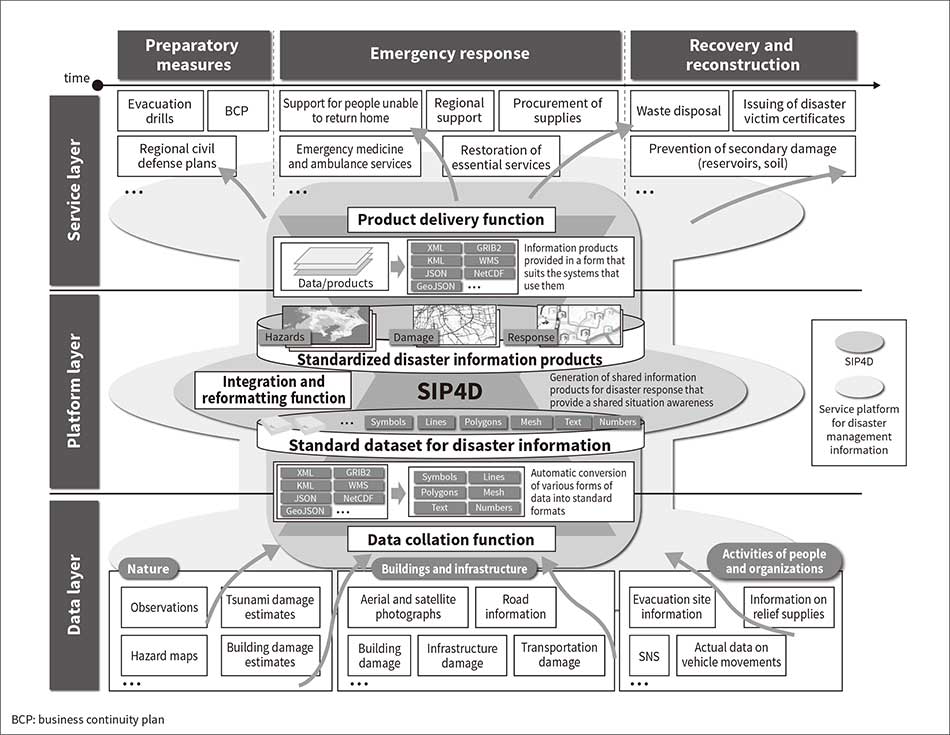Disaster Management and Security Solutions for a Safe and Secure Way of Life
Development of Sharing Information Platform for Disaster Management
One of the challenges when a major disaster strikes is how to share information between central and local government bodies and other relevant agencies. This article reports on the current progress and future outlook for research and development of the Sharing Information Platform for Disaster Management being undertaken through the Cross-ministerial Strategic Innovation Promotion Program. Hitachi is contributing to safe and secure urban development that is resilient to disaster through the technologies it has built up over time for infrastructure systems and disaster information sharing.

Integrated Research on Disaster Risk Reduction Division, National Research Institute for Earth Science and Disaster Resilience. Current work and research Development of information sharing systems.Society memberships: The Society for Risk Analysis Japan (SRAJ), the Japan Society for Disaster Information Studies (JASDIS), the GIS Association of Japan (GISA), and the Japan Society of Civil Engineers (JSCE).

Security Research Department, Center for Technology Innovation – Systems Engineering, Research & Development Group, Hitachi, Ltd. Current work and research: Research and development of disaster prevention / crisis management systems. Society memberships: The Information Processing Society of Japan (IPSJ) and JASDIS.

Business Development Centre, Market Development & Planning Department, Marketing Division, Defense Systems Business Unit, Hitachi, Ltd. Current work and research: Commercialization of disaster prevention / crisis management systems.

Intelligence Department, Intelligence and Information Systems Division, Defense Systems Business Unit, Hitachi, Ltd. Current work and research: Design and development of disaster prevention / crisis management systems.
Confronted with risks from a variety of natural disasters, including earthquakes, tsunamis, and heavy rain, the need to create a society that is resilient to disasters has been a challenge that Japan has faced for many years. Moreover, with society's vulnerabilities growing, the potential for disasters that affect the entire country, such as an earthquake centered on Tokyo or in the Nankai Trough, makes the improvement of nationwide disaster readiness a pressing issue.
Because the response to a disaster involves numerous organizations acting in parallel, it is important to achieve a common overall situational awareness and to use this as a basis for ensuring that each organization takes the correct action. Doing so requires information. Making the same information available so that everyone can utilize it in their response enables a shared situational awareness resulting in the best overall outcome.
In 2014, the Council for Science, Technology and Innovation of the Cabinet Office launched the Cross-ministerial Strategic Innovation Promotion Program (SIP) that transcends the boundaries between government agencies and traditional demarcations. The program includes an initiative called “Enhancements to Resilient Functions for Preventing and Minimizing Disasters,” with one of its goals being the research and development of information sharing systems based on information and communications technology and ways of utilizing them at disaster response agencies(1). In response, Hitachi collaborated with the National Research Institute for Earth Science and Disaster Resilience (NIED) to propose a research and development project for an information sharing platform for disaster management to be used by government, covering both the system itself and ways of using it. The proposal was accepted and Hitachi is currently proceeding with the project, with responsibility for research, which is called the Sharing Information Platform for Disaster Management (SIP4D). The following sections provide an overview of the system and describe how it is used in an actual disaster as well as plans for the future.
As noted above, there is a need when responding to a disaster for the large number of organizations involved, including central and regional government bodies and other agencies with responsibilities for disasters, to achieve a shared situational awareness and use this as a basis for taking the right actions in their respective areas. This calls for both the sharing of information between organizations and for timely provision of useful information on the ground.
SIP4D serves as a hub and intermediary that interconnects the numerous independent information systems that have been developed and operated by different organizations, and distributes information widely among government agencies, local governments, the private sector, and others. In contrast to the requirement in the past for a separate means of communication between each organization or system (N × M interconnections), using SIP4D as an intermediary means that each organization or system only needs a way of communicating with SIP4D to enable the sharing of disaster information (N + M interconnections) (see Figure 1).
Figure 1—Basic Concept of SIP4D By using the SIP4D as an intermediary for communications between different organizations and systems, all it takes to make disaster-related information available for shared use is to develop the functions needed to connect these information sources to the SIP4D (N+M interconnections).
By using the SIP4D as an intermediary for communications between different organizations and systems, all it takes to make disaster-related information available for shared use is to develop the functions needed to connect these information sources to the SIP4D (N+M interconnections).
As shown in Figure 2, SIP4D includes a data analysis and registration function for collating information that the various organizations and systems handle in a variety of different formats, a logical integration function for transforming the collated information into a form (disaster information products) that is of immediate use to the people responding to the disaster (users), and a data conversion and distribution function that converts the transformed information into the desired format before supplying it to users. To enable training exercises and to ensure that both providers and users of the information can have confidence in it and gain trouble-free access, SIP4D also has auxiliary functions that include support for training, information search, and access control.
The logical integration function ensures the timely provision of information by integrating fragmented information into a form that is useful during a disaster, and also by producing estimates to fill gaps in the available data. This function is a core technology in SIP4D. It is described in the following section.
Figure 2—Overview of SIP4D SIP4D collates information that various organizations and systems handle in a variety of different formats, transforms it into a form that is of immediate use to the people responding to the disaster, and converts it into the desired format before supplying it to them.
SIP4D collates information that various organizations and systems handle in a variety of different formats, transforms it into a form that is of immediate use to the people responding to the disaster, and converts it into the desired format before supplying it to them.
The logical integration function integrates disaster information that is acquired at different timings and in different forms, fills in gaps in the information, and transforms it into a form that is of immediate use to the people responding to the disaster. As shown in Figure 3, the function integrates fragmentary information, including details of damage to roads, actual data on vehicle movements, and hospital information, and provides it in a form that is of immediate use for activities such as patient transfers by including information needed for this purpose, such as locations of medical facilities and evacuation sites and which roads can be used. If the information needed is not yet available, the function fills in the gaps by using what information is available to produce estimates, where possible.
Figure 4 shows an example of information on damage to roads generated by the logical integration function. Information about which roads are passable, for example, is essential to personnel transporting patients. However, acquiring the information on damage to roads takes time and it is difficult to determine the overall situation, especially in the early stages of a disaster. To overcome this, the logical integration function estimates which roads are passable based on information on flooding obtained by images taken by helicopter, or road infrastructure maps (from the Ministry of Land, Infrastructure and Transport) and hazard maps that can be acquired prior to the disaster, as well as information from the small number of locations (points) for which details of damage to roads have already been collected.
The first step is to join the points and lines using the locations with damage and road infrastructure maps to identify roads (lines) that have a high likelihood of being impassable because they go through or close to locations with damage. The function also joins lines and areas using the road infrastructure maps and information on the extent of flooding to identify roads (lines) that have a high likelihood of being impassable because they go through flooded areas. Finally, it joins multiple lines to combine all of the likely impassable roads (lines) identified in the previous steps into one. In this way, by combining the fragmentary information that is available, an interpolated version of the desired information can be made available quickly even before the actual information on whether roads are passable has come in.
Figure 3—Logical Integration Function Based on an integration processing model that defines the information needed for disaster response and its interrelationships, the function integrates fragmentary information using substitution, inference, and interpolation to supply information to the people on the ground in a form that is immediately useful for their work.
Based on an integration processing model that defines the information needed for disaster response and its interrelationships, the function integrates fragmentary information using substitution, inference, and interpolation to supply information to the people on the ground in a form that is immediately useful for their work.
SIP4D has an architecture similar to the cloud technologies using Hitachi data centers that were put in place for the Cabinet Office's Integrated Disaster Management Information System. This has involved establishing a resilient infrastructure designed for continuous 24-hour/365-day operation that will always be available to disaster response personnel, wherever they are in the country.
SIP4D is intended specifically for the sharing and use of information by the agencies and other organizations active on the ground, especially the local disaster response headquarters run by the government but also including designated organizations for dealing with disasters, regional agencies, and disaster medical assistance teams (DMATs). In practice, SIP4D has provided DMATs with information on a wide variety of different forms of damage caused by large earthquakes, typhoons, or rainstorms, including storm damage, or snow damage in the case of cold climates (see Table 1).
The following section describes the main uses of SIP4D during the Kumamoto earthquake that struck in FY2016.
Table 1—Major Disasters in which SIP4D was Deployed Use of SIP4D in the response to actual disasters began in FY2015. It has been used to share information with the people responding on the ground at a variety of disasters, including major earthquakes, storm damage, landslides, and snow damage.
Use of SIP4D in the response to actual disasters began in FY2015. It has been used to share information with the people responding on the ground at a variety of disasters, including major earthquakes, storm damage, landslides, and snow damage.
“I expect the earthquake has caused a lot of damage.”
This was the report received from DMAT headquarters immediately after the main shock that struck at around 1:25 AM on April 16, 2016 and measured an upper 6 on the seven-point Japanese seismic scale (later revised by the Japan Meteorological Agency to 7).
Although SIP4D had already issued damage assessments and other information to the systems to which it is linked based on the seismic intensity distribution of a foreshock of intensity 7 that struck Kumamoto Prefecture at around 9:26 PM on the 14th, no information on major damage had yet come in apart from reports of power failures at some hospitals in the affected area. Even though the measured intensity of the main shock when it came some 28 hours later was not as large as that of the foreshock damage to buildings over a wide area was predicted. In the immediate aftermath of the earthquake, SIP4D was able to help achieve a shared situational awareness and make work more efficient by providing a large amount of information to the responders on the ground. This was achieved through the collection of information by the NIED's government emergency response headquarters for the area struck by the disaster and work on data coordination by Hitachi's office in Yokohama.
The main activities for which SIP4D was used were as follows.
This was particularly the case for the Kumamoto earthquake where many evacuees went to non-designated evacuation sites. By later collating and providing information from local municipalities, SIP4D also contributed to activities such as the subsequent health management of evacuees by public health nurses.
Figure 5—Example Provision of Information on Seismic Intensity Distribution The map shows the seismic intensity distribution for the main shock that struck the Kumamoto region at 1:25 AM on April 16, 2016 (estimated seismic intensity at surface).
The map shows the seismic intensity distribution for the main shock that struck the Kumamoto region at 1:25 AM on April 16, 2016 (estimated seismic intensity at surface).
Figure 6—Example Display of Road Closures and Actual Data on Whether Roads Passable for the Kumamoto Earthquake Information on road closures from the Ministry of Land, Infrastructure and Transport and actual data on whether roads were passable from ITS Japan were displayed during the Kumamoto earthquake to share it with DMATs, Self-Defense Forces, and others.
Information on road closures from the Ministry of Land, Infrastructure and Transport and actual data on whether roads were passable from ITS Japan were displayed during the Kumamoto earthquake to share it with DMATs, Self-Defense Forces, and others.
As described above, SIP4D has been beneficial for information sharing at a variety of different disaster sites. A team was set up in April 2017 to establish a disaster information hub that would develop rules for how to use and share information that is useful during disaster response and held by private-sector companies, organizations, and both central and local government agencies, and to facilitate coordination between the public and private sectors, with the Cabinet Office playing a central role(9).
NIED and Hitachi proposed 65 draft “standardized disaster information products” for this team.
Figure 7 shows the form that SIP4D will take in the future.
As a future service platform for disaster management information that underpins Society 5.0, SIP4D aims to provide a disaster management information service that supplies “standardized disaster information products” (collated data on things like the natural environment, buildings, infrastructure, and the activities of people and organizations) to central and regional government agencies, private-sector companies and organizations, and others.
Hitachi aims to continue contributing to safe and secure urban developments that are resilient to disasters by utilizing the technologies it has built up over time in infrastructure systems and the sharing of disaster information.
Figure 7—Service Platform for Disaster Management Information that Underpins Society 5.0 The platform collates information on the natural environment, buildings, infrastructure, and the activities of people and organizations and supplies it to local government agencies, the private sector, and others in the form of “standardized disaster information products.”
The platform collates information on the natural environment, buildings, infrastructure, and the activities of people and organizations and supplies it to local government agencies, the private sector, and others in the form of “standardized disaster information products.”